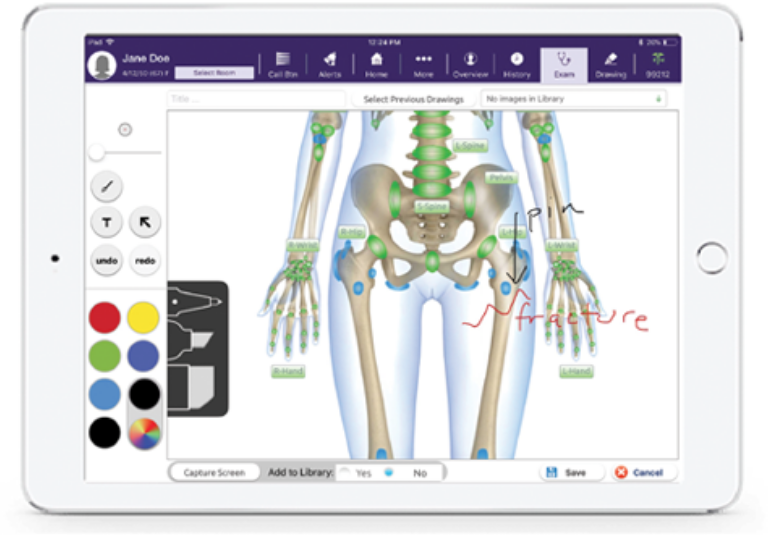A Blueprint for Choosing Orthopedic EMR Software
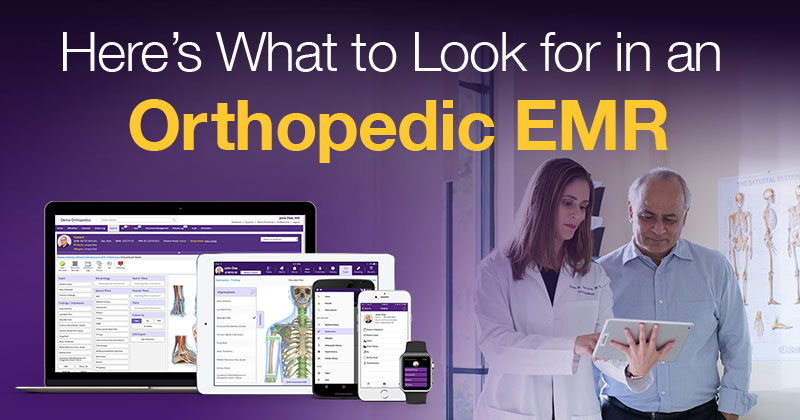
When adopting or switching orthopedic EMR systems, it’s crucial to have a well-defined plan, because your choice can impact everything from your bottom line to your work/life balance.
To make the search easier, we’ve laid out a framework of orthopedic software features that can help add more time back into your day—so you can spend fewer hours in the office and more time doing what you want to do.
To find the best orthopedics EMR software, look for the following capabilities:
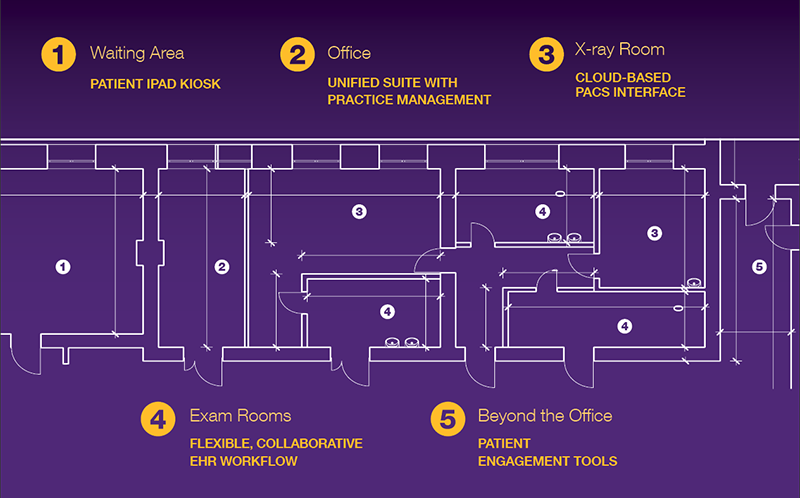
1. Waiting area: Easy-to-use patient iPad kiosk
The patient experience doesn’t start with exam documentation; it includes every touchpoint patients have with your practice. To help make the process easier for both your patients and your staff, look for orthopedic EHR software that can help you streamline each step in the patient journey.
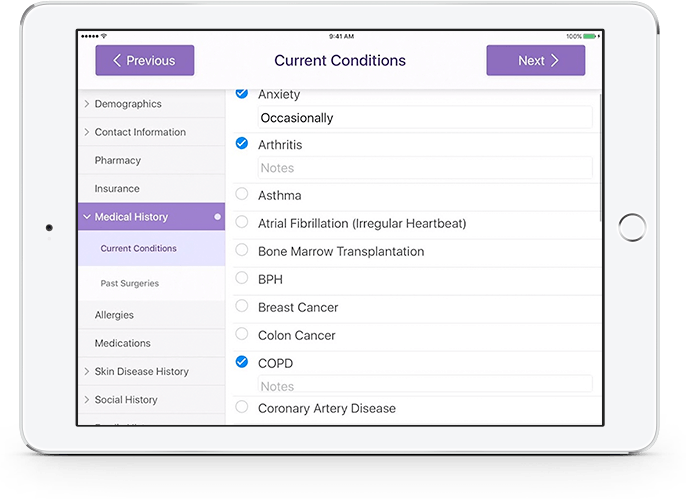 Once the patient arrives in your office, providing a seamless experience starts with the way you collect data in the waiting room. Paper forms can create extra work for everyone, so opt for an iPad patient kiosk instead. As part of an all-in-one solution with your EHR for orthopedics, an integrated patient kiosk can help eliminate paper intake forms and save staff time on data entry. Some patient self-service kiosks even allow patients to complete certain quality measures for you!
Once the patient arrives in your office, providing a seamless experience starts with the way you collect data in the waiting room. Paper forms can create extra work for everyone, so opt for an iPad patient kiosk instead. As part of an all-in-one solution with your EHR for orthopedics, an integrated patient kiosk can help eliminate paper intake forms and save staff time on data entry. Some patient self-service kiosks even allow patients to complete certain quality measures for you!
Also, keep in mind that some of the patients who will be using your iPad kiosk app won’t be particularly tech savvy. A topnotch orthopedic EHR vendor should take a user-centered design approach to help make sure their kiosk delivers a friendly user experience.
2. Office: Unified suite with practice management
As mentioned earlier, choosing an EMR is ultimately about more than just choosing an EMR—you’re choosing a vendor ecosystem for your practice. Yes, it’s possible to inhabit multiple ecosystems simultaneously, such as using EMR and practice management systems from different vendors. The trouble is, trying to connect these separate ecosystems via system bridges can get expensive and cause a host of complications.
For many orthopedic surgeons, the simplest option can be an EMR that provides an all-in-one solution for your entire practice. In fact, the 2018 Black Book™ survey of 18,950 physician practices found that practices using an all-in-one solution reported higher satisfaction than those combining separate systems. As Health Data Management puts it, a unified platform “supports clinician workflow and patient coordination, helping clinicians better succeed in a value-based care environment.”
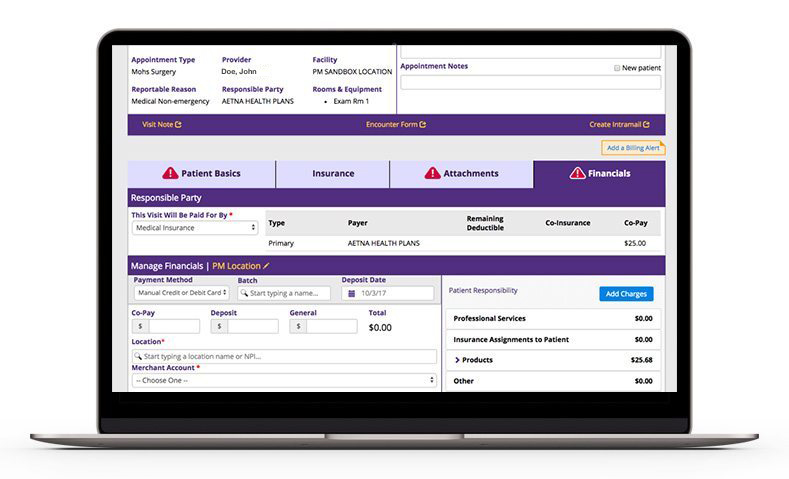 By using EMR and orthopedic practice management software from the same vendor, you can truly bring the front and back offices together while helping improve office flow and collections. Look for a system that gives staff easy access to what they need to complete tasks efficiently, collect balances on time and deliver superior patient experiences. For instance, if a patient asks about follow-up care details, next steps, outstanding balances or provider recommendations at checkout, your receptionist should be able to have all those answers at their fingertips.
By using EMR and orthopedic practice management software from the same vendor, you can truly bring the front and back offices together while helping improve office flow and collections. Look for a system that gives staff easy access to what they need to complete tasks efficiently, collect balances on time and deliver superior patient experiences. For instance, if a patient asks about follow-up care details, next steps, outstanding balances or provider recommendations at checkout, your receptionist should be able to have all those answers at their fingertips.
Of course, it’s also important that you consider the needs of your specialty. To help streamline your orthopedic medical billing, make sure your PM system includes integrated case and claim management. You should be able to create and track workers’ comp, auto, and PIP cases, submit claims electronically or by paper, and post payer and patient payments seamlessly within the orthopedic practice management software.
3. X-ray room: Cloud-based PACS system interface
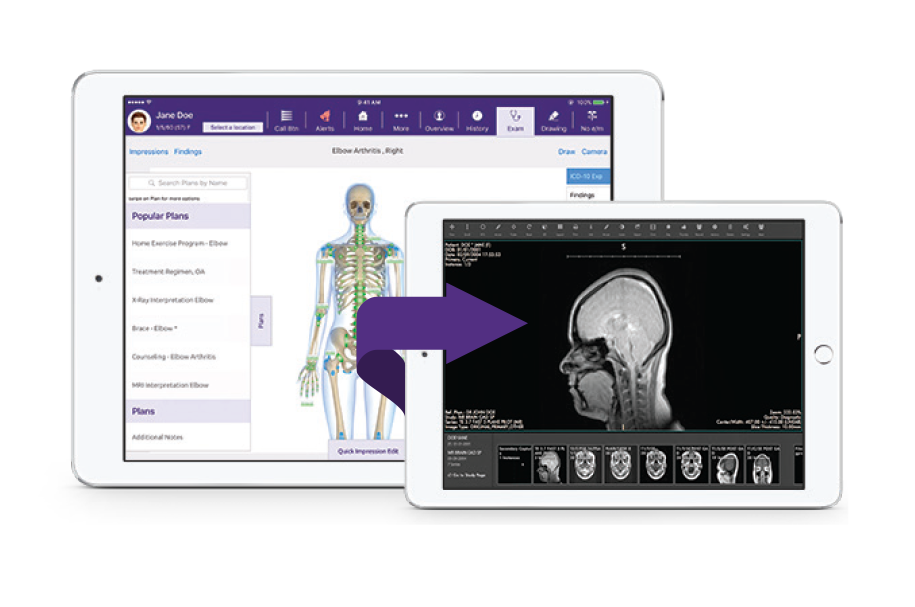
Tired of having to log into separate systems? Opt for an orthopedic EHR that interfaces with a cloud-based PACS and image management platform to give you one-click access to patient images. This can allow you to view DICOM modalities, including MR, CT, PET, CR, US and MG, on virtually any web-connected computer or tablet. Some systems even store non-DICOM imaging side-by-side with DICOM, so you can get a holistic view of all your patient imaging.
4. Exam rooms: Flexible, collaborative EMR workflow
The best orthopedics EMR software feels like you designed it yourself. Rather than forcing you to change the way you do things, it should easily adapt to your practice and to each user.
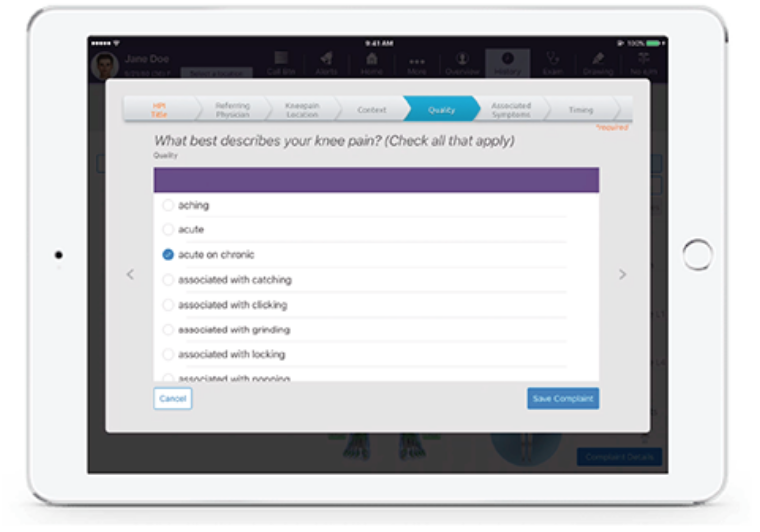 Look for an intuitive interface that’s simple to learn and easy to use for people in all roles—whether they’re a seasoned physician who’s used to paper or a newly hired tech who’s still learning orthopedics. The right orthopedics EMR system can help people do their jobs better instead of getting in the way.
Look for an intuitive interface that’s simple to learn and easy to use for people in all roles—whether they’re a seasoned physician who’s used to paper or a newly hired tech who’s still learning orthopedics. The right orthopedics EMR system can help people do their jobs better instead of getting in the way.
For example, some orthopedic EMRs show each patient’s exam room location in real time, helping you move them through the practice more efficiently. In addition, look for the ability to manage orders in one place and to have multiple users work on the same note simultaneously.
5. Beyond the office: Robust patient engagement tools
After the visit ends, how easy is it for your patients to stay in touch with you and access their electronic health records?
This can depend on your choice of orthopedic EMR software, since a patient portal typically comes as part of the EMR. As healthcare becomes more consumerized and patients increasingly expect topnotch experiences, look for an orthopedic patient portal that lets them:
- Access test results
- View and update their medical records
- Read educational handouts on disease processes and therapeutic medications
- Request medication refills
- Send encrypted online messages to your practice
When patients can easily find the answers they’re looking for online, it can reduce the need for them to phone your office staff. Plus, a robust patient portal can help empower them to stay more informed, continue health conversations after the visit and play a bigger role in their own healthcare process.
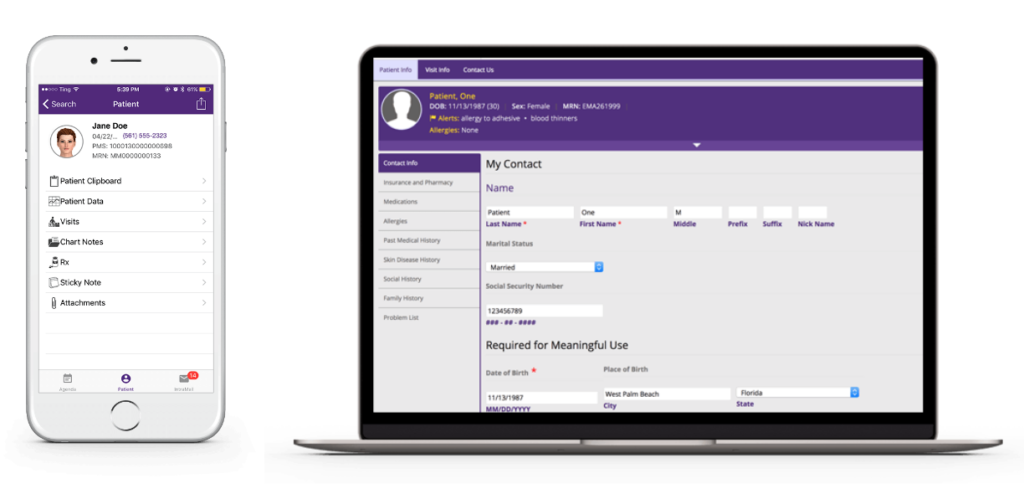
To help make your life a little simpler as you stay connected to your patients, also consider whether an orthopedic EHR provides a robust smartphone app. From virtually anywhere you have an internet connection, you should be able to easily message or call patients, view records, ePrescribe, edit notes and see your schedule for the day.
Other orthopedic EMR features to look for:
Orthopedic knowledge & adaptive learning
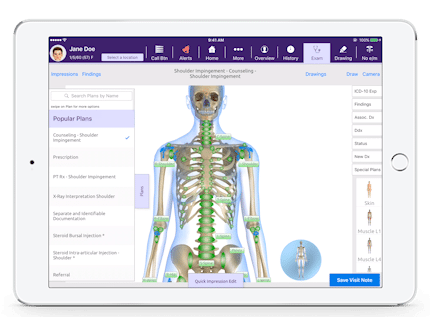
Rather than spending days or even weeks building orthopedic templates, choose EHR software with histories, ICD-10 diagnoses, treatment plans and more built in by orthopedists. Your orthopedic software should also remember your top clinical scenarios and adapt to each physician’s unique preferences. This allows you to quickly capture the data needed for accurate orthopedic billing while keeping control of the output.
Automatic coding suggestions
The best orthopedics EMR software can make paper superbills and ICD-9 to ICD-10 conversion tools a thing of the past. Look for a system that suggests orthopedic ICD-10, CPT and modifier codes for you based on what you’ve documented, helping streamline your orthopedic medical billing and coding. 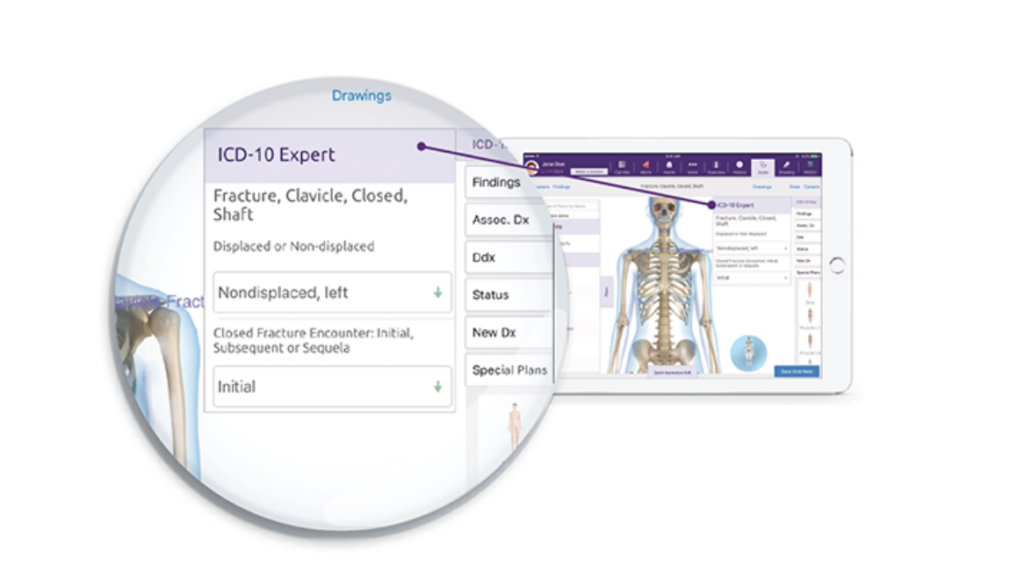
Some orthopedic EHRs can even capture and display your E&M code as you document, and if you believe the visit warrants a higher E&M level, they can alert you of the criteria needed to reach it. This could lead to additional revenue.
But that’s not all that an EHR can do for your orthopedic billing. Look for a system that can benchmark each provider’s E&M code utilization against other providers in your practice and against CMS Medicare Part B utilization data. This can help you stay on top of your orthopedic billing compliance and help you to identify and fix any problematic coding patterns.
MIPS dashboard
As quality reimbursement affects more and more of orthopedic surgeons’ revenue, you’ll want a built-in MIPS solution that makes CMS’ complex MACRA regulations simpler for you with an easy-to-use dashboard. Without adding lots of extra time or clicks, the EHR 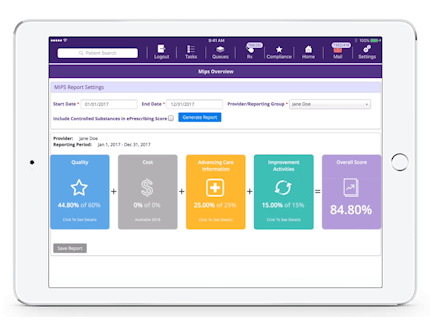 should be able to capture your MIPS data within the flow of the exam and compile it in a robust scorecard for you to analyze later.
should be able to capture your MIPS data within the flow of the exam and compile it in a robust scorecard for you to analyze later.
In particular, look for the ability to track your progress (in each category and overall) on a daily basis. Not just monthly or quarterly—daily. That way, you and your staff can keep a close eye on what MIPS measures you’ve met and, if necessary, make adjustments to help improve your performance before the year is up.
When it finally comes time to report, your orthopedic EHR system should make that process easy, too. A few minutes is all it should take, with no need for you to visit a separate website and attest manually.
Instant documentation
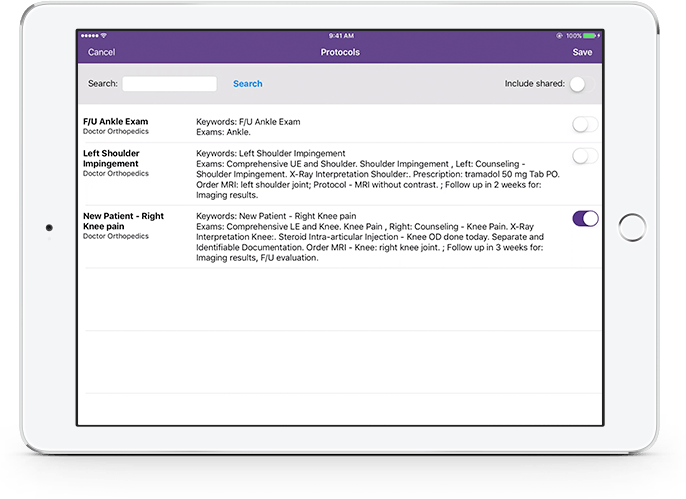 For your most frequently encountered conditions, operative notes and post-op appointments, you can save substantial amounts of time by choosing an orthopedic EMR that lets you build custom “master visits.” Look for the ability to pre-record data like demographics, diagnoses, procedures, treatments and more, then apply that data during the visit in a few clicks to generate a comprehensive clinical summary.
For your most frequently encountered conditions, operative notes and post-op appointments, you can save substantial amounts of time by choosing an orthopedic EMR that lets you build custom “master visits.” Look for the ability to pre-record data like demographics, diagnoses, procedures, treatments and more, then apply that data during the visit in a few clicks to generate a comprehensive clinical summary.
For example, you can instantly document:
- A geriatric patient with knee osteoarthritis who isn’t a surgical candidate, with recommendations for weight loss and physical therapy
- Tennis elbow with a conservative treatment regimen of rest, wearing a splint and icing
- An annual osteoporosis screening visit with prescription of calcium, vitamin D and a bone density check
At first, this functionality may sound similar to orthopedic templates. But unlike templates, these master visits, or “protocols,” can be altered on the fly, so you can make sure you’re saying what you want to say for each patient instead of getting stuck with preloaded, unaccommodating answers.
The right technology adapts to fit your workflow—not the other way around.
Cloud technology
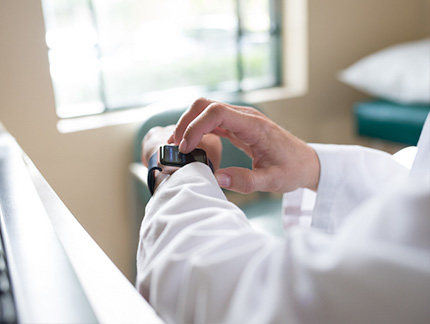 This one is pretty straightforward: your practice could end up with a wide range of IT costs and headaches if you opt for a server-based orthopedic EMR system. That’s why the industry has been moving towards cloud-based orthopedic software systems. They’re simple to set up, need little hardware and can be accessed from virtually anywhere. Plus, the cloud eliminates disruptive manual EMR software updates.
This one is pretty straightforward: your practice could end up with a wide range of IT costs and headaches if you opt for a server-based orthopedic EMR system. That’s why the industry has been moving towards cloud-based orthopedic software systems. They’re simple to set up, need little hardware and can be accessed from virtually anywhere. Plus, the cloud eliminates disruptive manual EMR software updates.
iPad mobility
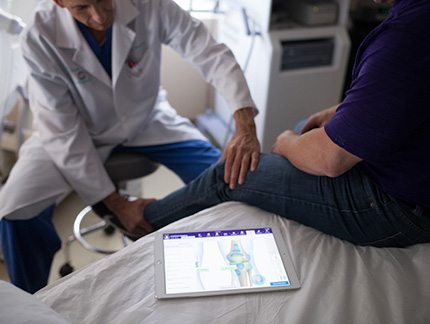 You didn’t go into orthopedic surgery to sit at a computer typing for hours. So, opt for a touch-based orthopedic EHR that’s built for iPads as well as desktops. Instead of turning your back, you’ll be free to move around the room and engage with your patients.
You didn’t go into orthopedic surgery to sit at a computer typing for hours. So, opt for a touch-based orthopedic EHR that’s built for iPads as well as desktops. Instead of turning your back, you’ll be free to move around the room and engage with your patients.
Even better, a quality iPad EHR is designed to reduce the total number of clicks needed to document an encounter. Some can automatically generate notes, encounter forms, bills, orders, prescriptions, educational handouts and more right at the point of care. Before the patient even leaves the room, your documentation can be done!
Body diagrams & drawing tools
The iPad can be more than just an efficient documentation tool—it can facilitate meaningful healthcare conversations. For instance, your NP or surgical coordinator can use interactive anatomical images on your iPad EMR to educate patients about their condition. They can even use built-in drawing tools to illustrate future surgical interventions, such as showing where a fracture is and where the rod will be inserted.
Powerful, actionable analytics
It’s hard to improve your performance if you can’t effectively track it. That’s why it’s crucial to look for a powerful business intelligence platform integrated with your EHR and orthopedic practice management software. 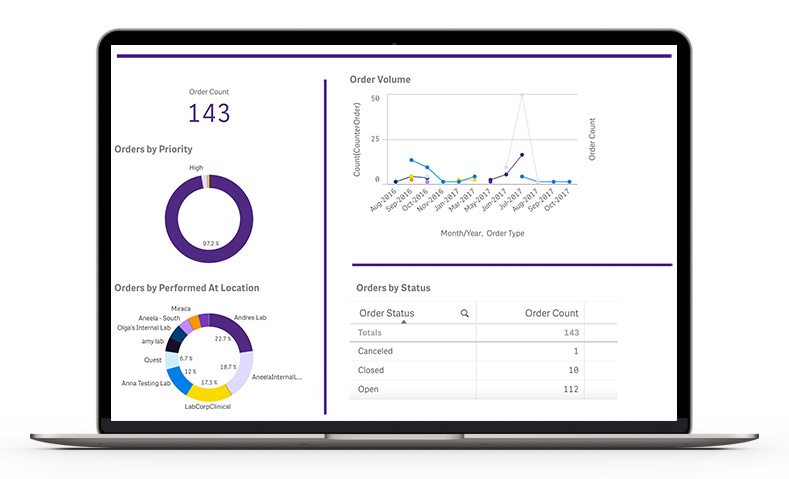
The best orthopedic analytics software brings together your clinical, financial and operational data in customizable reports that let you drill down to the specifics. This can allow you to answer both clinical queries like “how many patients have I seen this year with patellar tendonitis?” and business queries, such as “how many times have I taken patient X to the operating room?”
Here are a few examples of other questions robust orthopedic analytics software should be able to answer:
- How many carpal tunnel patients did you order surgery for?
- How many level 4 new-patient encounters did you have this year compared to peers?
- How many patients in your practice received PRP or Viscosupplementation injections?
- Which osteoporosis patients who sustained fractures were lost to follow-up?
Final thoughts
As you can see, choosing the right orthopedic EMR software should involve looking at much more than the clinical documentation side. Ultimately, it should mean thinking strategically about what your software choice can mean for all aspects of your practice.
By looking at the whole picture and laying out a cohesive blueprint for what you want, you can help ensure that you’re building your practice ecosystem on a strong foundation. We wish you all the best in your search.
In Black Book’s independent 2018 survey, hundreds of orthopedic physicians, staff and healthcare leaders ranked Modernizing Medicine®‘s EMA™ EMR #1 among orthopedic EMRs.
